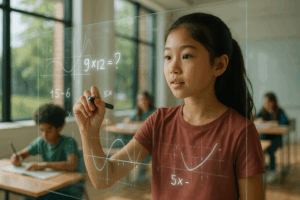Introduction
The smell of a new textbook once marked the start of every school year. Parents flipped through its glossy pages, teachers planned lessons around its chapters, and students scribbled answers into the same standardized exercises.
But in 2025, those pages are turning for good.
At Alpha School, no child opens a printed textbook. Each student logs into an AI tutor that generates lessons in real time — personalized to their strengths, weaknesses, and even interests. “Textbooks are static,” says founder Joe Liemandt. “They assume every kid learns the same way, at the same pace. But they don’t.”
If knowledge changes daily, why are so many schools still teaching from books written years ago?
At Alpha School, textbooks are obsolete. Generative AI builds every lesson around a student’s mastery level and curiosity — ending one-size-fits-all learning.
In This Guide
- Why Traditional Textbooks No Longer Work
- The Rise of Generative AI Curriculum
- Inside Alpha’s Real-Time Learning Engine
- How Personalization Outperforms Standardization
- What This Means for Teachers and Parents
- FAQs About Life After Textbooks
- Conclusion & Next Steps
Why Traditional Textbooks No Longer Work
For more than a century, textbooks represented authority — the final word on what students should learn. But printed materials follow multi-year adoption cycles, meaning content often lags behind new research or current events.
Liemandt compares static curriculum to “handing every kid the same map, even though they start on different roads.” The result: some students get lost, others race ahead, bored.
Research supports this concern. John Hattie (2023) highlights the large positive impact of adaptive feedback (effect size ≈ 0.7) and the minimal gains from static, one-pace instruction.
“Every learner’s brain is different,” Liemandt says. “If we can personalize everything else in life — playlists, workouts, meals — why not learning?”
At Alpha, the textbook has been replaced by a dynamic, real-time learning stream that updates itself every day, for every child.
The Rise of Generative AI Curriculum
Generative AI is doing for education what the internet once did for research.
Instead of flipping through a single-author textbook, students now learn from an AI engine that synthesizes vetted content, creates examples on the fly, and adapts each lesson to the learner’s mastery level.
At Alpha, the AI tutor doesn’t just serve content — it writes it, combining what a child knows (the Knowledge Graph) with what excites them (the Interest Graph). If a student loves Taylor Swift, history lessons might frame 20th-century diplomacy as the logistics of a global tour.
Each lesson is generated and verified in real time, reflecting new discoveries or a student’s evolving curiosity.
“There’s no such thing as the lesson anymore,” Liemandt says. “There’s only your lesson.”
The “curriculum of one” has replaced the textbook for all.
Inside Alpha’s Real-Time Learning Engine
Alpha’s classroom runs on what Liemandt calls a real-time learning engine, composed of five key layers:
- Diagnostic Mapping: Each morning, AI analyzes mastery data to identify what students know and where they struggle.
- Dynamic Lesson Generation: Using generative AI, it builds new lessons aligned to mastery goals and interests.
- Feedback Loop: A vision model detects off-task behavior and encourages self-correction.
- Verification Layer: Human guides audit AI-generated lessons for accuracy and academic alignment.
- Personal Mastery Tracking: Each skill must reach 90% proficiency before students advance.
Two students side by side may study completely different topics — each guided by an AI engine tuned to their pace, interests, and goals.
How Personalization Outperforms Standardization
When Alpha abandoned textbooks, skeptics questioned rigor. The results have been striking.
Students complete a full grade level in 20–30 hours of focused study — roughly 10× faster than traditional pacing. Standardized MAP Growth tests place them in the top 1–2% nationally.
Supporting research reinforces these outcomes:
- Bloom (1984) found that one-on-one mastery tutoring yields two standard deviations higher achievement than group instruction.
- Hattie (2023) identified adaptive feedback as one of the most powerful learning accelerators (effect size ≈ 0.7).
- EEF (2021) reported that individualized feedback can double retention.
And the most powerful ingredient? Motivation.
“Motivation is 90 percent of the solution,” Liemandt says. “When kids love what they’re learning, you can’t stop them.”
What This Means for Teachers and Parents
In a world without textbooks, teachers don’t disappear — they evolve.
Alpha’s educators act as guides, not lecturers. Each mentor supports a small cohort of students, helping them reflect, set goals, and apply learning in real-world projects.
Freed from grading piles, guides focus on motivation and mentorship. They report reduced after-school workloads because feedback is automated.
Parents gain transparency through dashboards that show real-time progress instead of end-term grades. Learning becomes a living, visible process — not a static 500-page book.
FAQs About Life After Textbooks
Q1. Does this mean schools no longer use any books?
Books remain for literature and research, but core academics — math, science, and social studies — are AI-generated daily.
Q2. How is accuracy ensured in AI lessons?
Each AI output passes through Alpha’s human verification layer. Guides review and approve flagged content for accuracy and alignment.
Q3. Do students miss foundations without chapters?
No. Alpha’s mastery model ensures at least 90% understanding before progress — the digital equivalent of Bloom’s mastery tutoring.
Q4. Will other schools follow?
Liemandt predicts global adoption within five years, powered by affordable AI tutors and sub-$1,000 tablets capable of offline learning.
Q5. What about screen time?
Students work in short, 25-minute focus intervals. Afternoons are reserved for collaborative projects, athletics, and hands-on learning.
Conclusion & Next Steps
The textbook defined the industrial age of education — standardized, structured, and slow.
AI defines the post-industrial age — personalized, adaptive, and alive.
“Textbooks taught yesterday’s students,” Liemandt says. “AI tutors teach today’s — and tomorrow’s — in real time.”
The era of one-size-fits-all learning is ending. In its place stands a model where every student receives a curriculum of one — written by AI, reviewed by humans, and driven by curiosity.
Parents can explore how Alpha’s mastery-based, AI-powered approach is replacing textbooks with real-time learning at https://alpha.school/the-program/.



